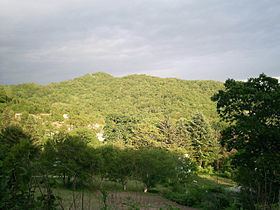Criteria x | Elevation 2,090 m (6,860 ft) Type Natural Designated 2001 (25th session) Country Russia | |
 | ||
Mountains Tordoki Yani, Anik Mountain, Mount Kholodilnik, Bo‑Dzhausa Mountain, Eagle's Nest Hill | ||
Sikhote alin meteorite documentary
The Sikhote-Alin (Russian: Сихотэ́-Али́нь; approximate pronunciation /siːkoʊˈteɪ ɑːˈliːn/ see-koh-TAY ah-LEEN) is a mountain range in Primorsky and Khabarovsk Krais, Russia, extending about 900 kilometres (560 mi) to the northeast of the Russian Pacific seaport of Vladivostok. The highest summits are Tordoki Yani at 2,077 metres (6,814 ft) above sea level, Ko Mountain (2,003 m) in Khabarovsk Krai and Anik Mountain (1,933 m) in Primorsky Krai.
Contents
- Sikhote alin meteorite documentary
- Map of Sikhote Alin Khabarovskiy Kray Russia 682909
- Sikhote alin mountains
- Geography
- History
- References
Map of Sikhote-Alin, Khabarovskiy Kray, Russia, 682909
Sikhote alin mountains
Geography
Although Sikhote-Alin is a temperate zone, species typical of northern taiga (such as reindeer and the Ussuri brown bear) coexist with tropical species, the Amur leopard, Siberian tiger, and the Asiatic black bear. The region holds very few wolves, due to competition with tigers. The oldest tree in the region is a millennium-old Japanese yew.
History
In the 1910s and 1920s, Sikhote-Alin was extensively explored by Vladimir Arsenyev (1872–1930) who described his adventures in several books, notably Dersu Uzala (1923), which in 1975 was turned into an Oscar-winning film by Akira Kurosawa. The large Sikhote-Alin and Lazo wildlife refuges were set up in 1935 to preserve the region's unusual wildlife.
On February 12, 1947, one of the largest meteor showers in recent history occurred in the Sikhote-Alin mountains. The Sikhote-Alin meteorite exploded in the atmosphere as it fell, raining many tons of metal on an elliptical region about 1.3 square kilometres (0.50 sq mi) in area. Craters were formed by the meteors; the largest was 26 metres (85 ft) in diameter.
In 2001, UNESCO placed Sikhote-Alin onto the World Heritage List, citing its importance for "the survival of endangered species such as the scaly-sided (Chinese) merganser, Blakiston’s fish-owl and the Amur tiger". The World Heritage site has a total area of 16,319 square kilometres (4,033,000 acres), of which the terrestrial core zone of Sikhote-Alin Zapovednik comprises 3,985 square kilometres (985,000 acres). The core zone can only be explored in a company of rangers.
